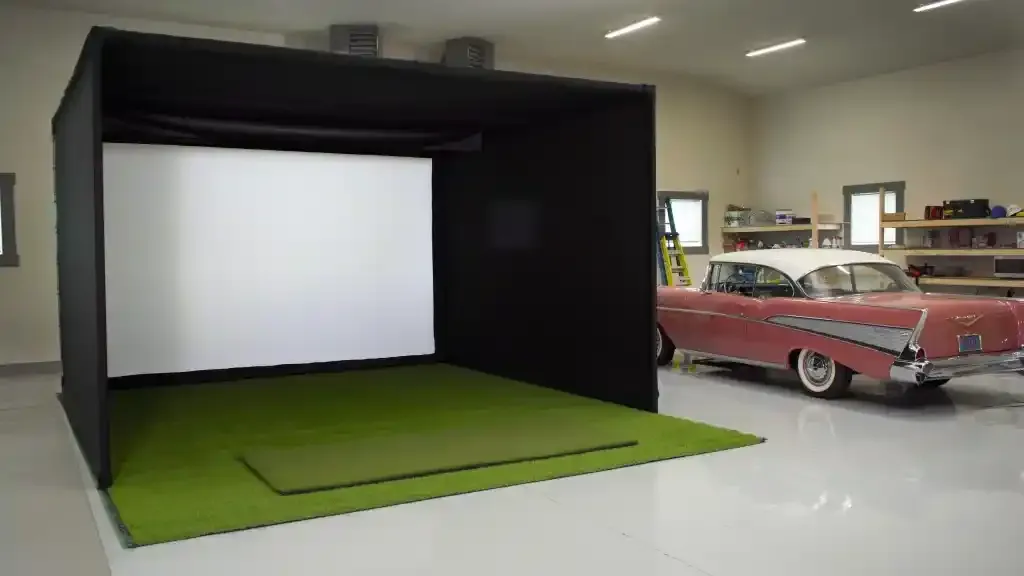
Are you a golf enthusiast who loves to play golf at all times? A brilliant garage golf simulator is the perfect idea for you. When you’re identifying that golf ball diameter and hitting your golf ball with full strength, golf is the only thing that comes into your mind. Golf is a passionate sport, and people worldwide like to play it. Why not create your golfing place and enjoy the spirit of golf practice? More than it sounds good, it is a fulfilling experience. Now, you must be thinking about how you can get the idea of making your golf course at your place. Worry not, as we are here for that. So, let’s dive into this adventurous world and learn how to set up a golf course at our place.

Garage Golf Simulator
Converting your garage, which is frequently unused space, into a center of athletic activity into a golf simulator is a great way to practice and enjoy golf in all weather. This project demands careful layout planning to guarantee enough room for swinging a club and installing equipment like impact screens, launch monitors, and golf simulation software. We’ll walk you through each process stage in this blog, from organizing your garage and choosing the best furniture to selecting and configuring the appropriate devices and accessories.
So let’s discuss how much room is needed, which golf mats and projectors are best for a home setup, and how to keep costs down. We’ll also cover how to improve your setup for comfort with heating and cooling and pointers to smoothly integrate your simulator with other garage features. Regardless of your skill level, this tutorial will assist you in setting up a functional and entertaining golf simulator at your house.

Garage Golf Simulator: Always Look for Space
Space Is Essential for Garage Golf Simulator
Space is the first thing to consider when setting up a golf simulator. Enough space in a garage or other designated storage location makes larger enclosures possible. A basic golf net cannot match these sets’ immersive and all-encompassing golfing experience. The available area fits the simulator’s physical size and improves playtime comfort and safety.
Gains from a Dedicated Setup
People say clients with separate garages or storage rooms typically have more room naturally or have expressly built their place for a simulator. This additional room is perfect for a medicated and long-lasting simulator setup. A separate space for the simulator makes the surroundings more orderly and uncluttered, improving the enjoyment and realism of the golfing experience.

Selecting the Proper Simulator
Before choosing the kind of simulator to install, it’s critical to consider the most essential functions. Knowing what you need, such as precise ball tracking, sophisticated visuals, or various virtual courses, will help you choose the suitable simulator model and configuration. If space permits, Nate advises directing clients toward configurations similar to the Pro Enclosures because they have many advantages over more basic ones.
Measurement of Garage Golf Simulator
Accurate dimensions and sufficient power supply planning are essential when installing a home golf simulator in your garage. These will help you choose the appropriate parts and guarantee a smooth installation.

Take a Survey of Your Area
Height
To ensure adequate room for swinging clubs comfortably, measure from floor to ceiling.
Width
Determine the side-to-side room needed for your screen or net and other tools, such as side obstacles.
Depth
Measure the distance between the rear wall and the garage door to ensure enough depth for you to swing freely and for the launch monitor to record data correctly.

Evaluate the availability of power outlets.
Ensure the designated setup space has adequate power outlets to accommodate several components without overloading one circuit.
Think carefully about where to position these outlets to connect your launch monitor, projector, computer, or tablet, and extra lighting without running many extension wires or creating trip hazards.
By carefully weighing these variables, you can select the best golf simulator parts that will fit nicely in your garage and satisfy your power requirements.

Materials Required for Garage Golf Simulator
Building a golf simulator in your garage is an excellent way to get better at golf from the comforts of your home. There are a few essential elements to remember while establishing a formal practice area or a comprehensive simulation environment.
Impact screen and enclosure
The enclosure creates a haven for your garage while enclosing your simulator area. The impact screen is essential because it simulates shots and courses while absorbing the force of golf balls. It should be firm and firmly fastened to prevent any sagging or tearing.
Golf Mats
Since garages typically have cement floors, a good golf mat is necessary to replicate the feel of a natural golf course and shield your clubs from impact damage. TrueStrike mats are very durable and authentic-feeling, which makes them highly recommended. They are available in different sizes, some of which include numerous striking areas.

Launch Monitor
This gadget is essential for monitoring your golf ball’s speed, angle, and distance. The golf simulator software uses the data from the launch monitor to precisely simulate the ball’s trajectory and landing place on the virtual golf course.
The software creates a graphic simulation of a golf course on your impact screen with the help of your launch monitor. Basic graphical representations and high-definition simulations of actual classes are among the available options.
Projector
A top-notch projector is required to display the simulation on the impact screen. A projector with a higher lumen output (such as the BenQ LU710 with 4,000 lumens) can ensure a bright and clear image in locations with ambient light, like a garage with windows. Consider the projector’s throw distance as well, particularly in tiny garages.

Hitting Mat
Unlike the giant golf mat, this is where you will stand and hit the ball. It should offer enough room and comfort for your stance and swing.
Space Needs
Make sure your garage’s height and floor area are sufficient. For a standard setup, you should be at least nine or ten feet tall with adequate room for all your clubs to swing, from drivers to wedges.

Golf Balls for Garage Golf Simulator
Using actual golf balls can add realism to the simulation, but make sure your impact screen and netting can handle them. If safety is a concern, practice or limited-flight balls can be an acceptable substitute.
Heating and Cooling
If your garage isn’t climate-controlled, install a heating and cooling system to keep your simulator comfortable all year.
Garage Door
If the garage door can be covered or insulated, it can help regulate light and temperature. This can also enhance the overall design of your simulator area and shield the door from any stray bullets.
Package for Golf Simulator
Numerous businesses sell complete golf simulator kits, including everything from the projector and software to the screen. These bundles can be an easy and frequently affordable method of acquiring everything you require with guaranteed compatibility.

How to Build a Golf Simulator in Your Garage
Here’s a proper DIY golf simulator building process that you can use outdoors and indoors. Constructing a golf simulator in your garage requires proper preparation and execution.
1. Determine the Need for Space
Make sure your garage is the right size. It should ideally be ten feet high, twelve feet wide, and fifteen feet deep. Take away anything extra, and keep the garage door’s swing in mind.
2. Choose Vital Elements
Invest in essential components such as a sturdy impact screen, a superior golf mat, a projector with sufficient lumens and resolution, a dependable launch monitor, and responsive golf simulation software.

3. Set up the Impact Screen and attach it.
Build a strong metal or wood frame to support the impact screen tightly. For a good view, make sure the screen is installed with as few wrinkles as possible.
4. Position the launch monitor and golf mat.
Align the golf mat with the screen’s center. Place the launch monitor behind or next to the mat, depending on the model’s technology (radar or photometric-based).
5. Setting Up Projectors
To provide the best show, place the projector immediately behind the playing area on a high shelf or on the ceiling. Make sure the projector is centered on the screen.

6. Installing and calibrating software
Install the golf simulator software and link the launch monitor and projector to it. Calibrate every piece of equipment to align the virtual and actual configurations.
7. Last-Minute Exams
Adjust the equipment location and settings for accuracy and comfort as you test your setup with many shots. This fine-tuning is essential to creating a realistic golf simulation.

Building a Garage Golf Simulator DIY: Things to Consider
1. Space Needs
Ceiling Height
Ensure the garage ceiling is high enough for your swing to hang securely. Nine or ten feet is the suggested minimum height.
Floor Space
You’ll need plenty of room for a safe swing area and the simulator setup. A room roughly 10 feet wide and 12 to 15 feet deep will do.
Screen Separation
Carefully consider how far you want to hit the screen from the hitting region. Balls can damage a screen if you are too close, and the projected image quality could be compromised if you are too far away.
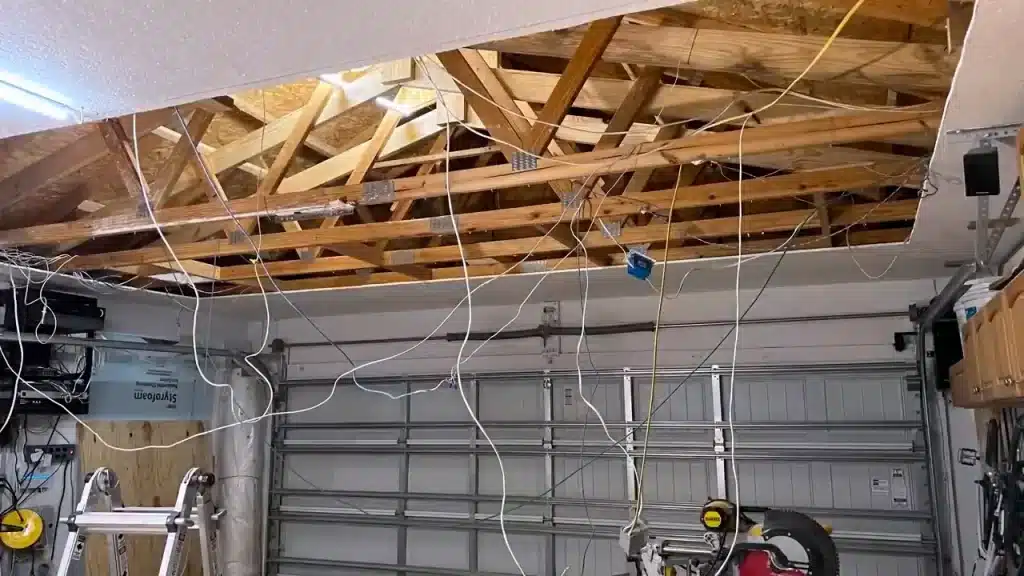
2. Lighting
Install angularly and dimmably adjustable LED lighting. By doing this, you may light up the playing field without erasing the image that is put onto the screen.
Avoid positioning lights directly above the player to avoid shadows on the screen.
3. Resistance to Noise
Consider building side panels and enclosures to reduce noise and guard against mishit balls damaging your simulator area.
These materials also help to soundproof the area, preventing noise disturbances from neighbors or other family members.
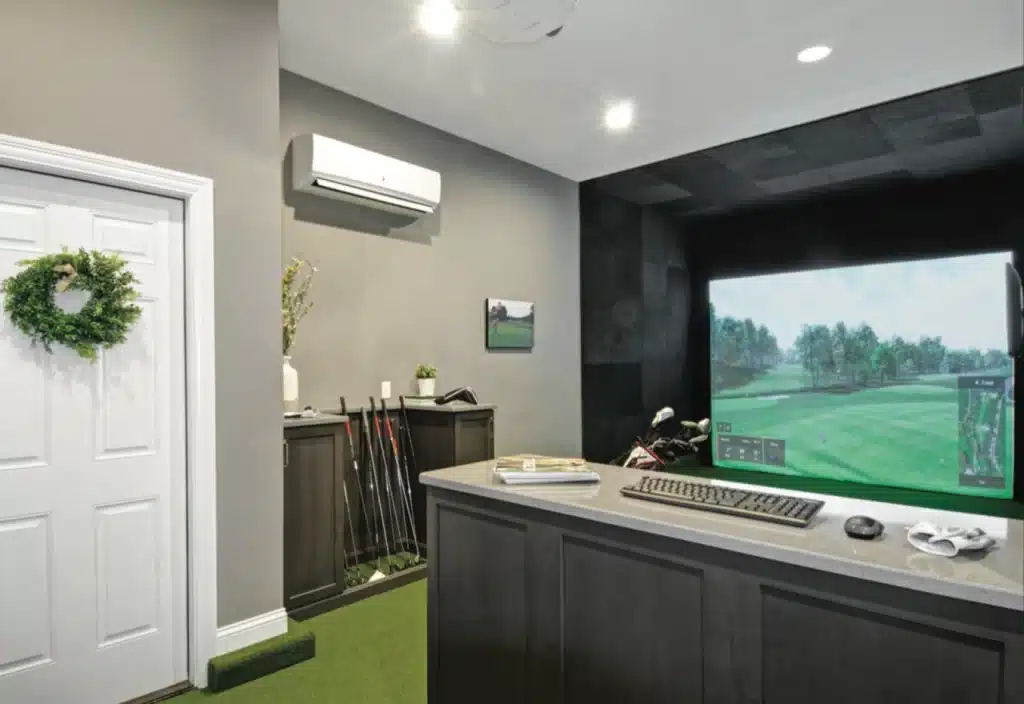
4. Control of Humidity and Temperature
Insulation
To keep the temperature in your garage constant, insulate the walls and doors.
Heating and Cooling
Depending on your environment, install a heating solution that provides both heating and cooling, such as a mini-split system, radiator, or portable heater.
Humidity
If the humidity in your location is excessive, use a dehumidifier to preserve comfort and equipment.
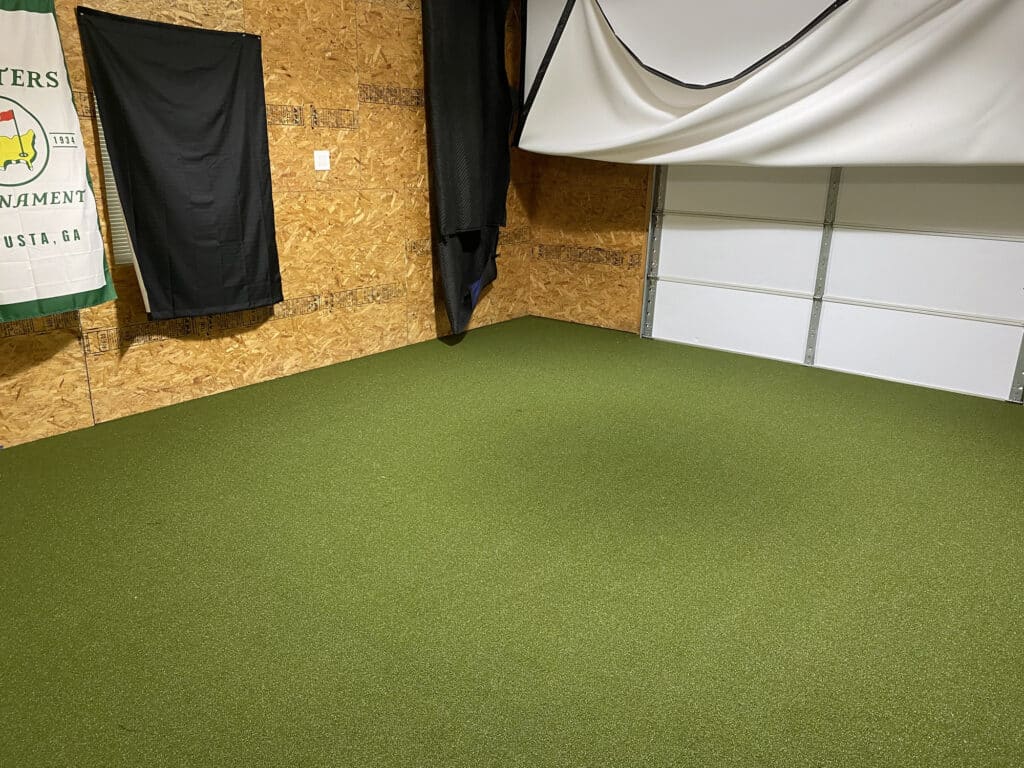
5. Flooring
To improve the authenticity of the simulator, use turf or specialty golf mats that mimic the texture of an actual golf course.
Ensure the surface is level and solid to encourage regular play and avoid injuries.
6. Power Supply and Safety for Garage Golf Simulator
Ensure enough power outlets for your lights, climate control, simulator, and other equipment.
To avoid trip hazards, keep safety in mind and arrange cords and wires carefully.
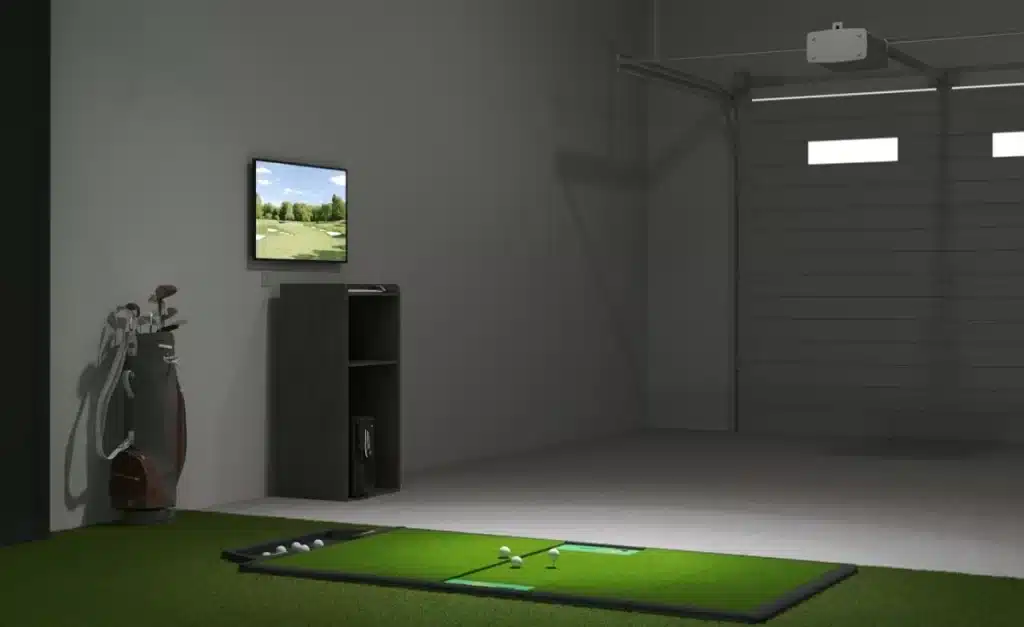
7. Equipment Quality and Budget
Decide on your budget early in the planning stage, as simulators can cost anywhere from a few thousand to tens of thousands of dollars.
Invest in high-quality parts that provide the most value for the money. Although cheaper options might save money upfront, they also increase maintenance expenses or less realistic simulations.
Garage Golf Simulator Packages
The SkyTrak+ Retractable, Mevo+ Retractable, and GC3 Practice Package are a few examples of garage-specific golf simulator packages that provide homeowners with the ideal combination of advanced golfing and compact storage. With these devices, enthusiasts can use cutting-edge technology and data analysis tools to practice swinging in the comfort of their garage. Retractable screens on the SkyTrak+ and Mevo+ allow you to quickly convert your garage to a space that can hold your car and golf practice area. This adaptability is essential for people who don’t have much room. The GC3 Practice Package is an excellent option for a multipurpose area because it emphasizes portability and durability. Installing a golf simulator setup in your garage makes the most of your available space and practice chances, which makes an excellent investment for dedicated golfers.

Final Thoughts: Garage Golf Simulator
Installing a golf simulator in your garage turns an average area into an amazing indoor retreat, ideal for enthusiasts who want to practice anytime, regardless of the weather. This post has covered all the necessary components for putting together a garage golf simulator setup, such as the amount of space requirements and the ideal configuration for the golf simulator. We discussed the materials needed, such as impact screens, golf matting, golf simulator projectors, and golf sim software. We also discussed the advantages of incorporating a setup like this into your garage to create a man cave with a golf simulator that maximizes garage space and improves your golfing experience.
In conclusion, the step-by-step construction guide for a golf simulator in your garage emphasizes the necessity of accurate measurement and thoughtful component placement, particularly for components like the golf launch monitors and golf simulator package. Using a do-it-yourself strategy not only lowers costs but also enables customization of the arrangement to suit individual tastes and garage dimensions. The benefits of owning a private golf getaway at home are enormous, and they can range from a simple golf setup to an elaborate golf simulator garage with heating and cooling for year-round comfort. If you consider these factors, you may train for golf in the comfort of your home with a garage golf simulator that not only meets but surpasses your expectations.





